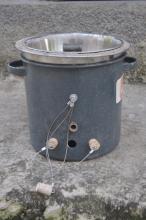On a recent trip to Haiti I was finally able to construct my CharBowl(tm) charcoal stove. It uses two nested stainless steel bowls (5 quart and 8 quart (4.7 liters and 7.6 liters))for durability and reflectivity with castable insulating refractory between them to reduce conductive heat losses. It has a 6.5" (16.5cm) dia cast iron grate for durability. It has a secondary air pipe to reduce CO emissions and increase heat output. The secondary air outlet pipe is 3/8" (10 mm) nominal (ID 0.493" 12.5mm; OD 0.675", 17mm) black iron with a Tee fitting on top to keep charcoal from dropping into it. 3/4" NC 10 (19mm 2.5) machine threads were cut over the pipe threads. This allowed the use of a split nut and flat washer inside and outside the bowls to hold the bowls together. The elbow is 3/8" to 1/2" . The inlet pipe is nominal 1/2" iron (ID 0.622" 16mm; OD 0.84", 21mm). The bowls sit on a stock pot base for stability and primary air control. (I couldn't get my hands on the stainless pot I really wanted to use for the base. I'm planning to build another with such a base now that I'm back in the States.)
I hope to get some testing done on my second prototype.
It can be used as the base of a TChar stove.Nike Air Force 1 '07 Lv8 Utility White/White-Black-Tour Yellow – nike dunk high pro sb kentucky derby 2017


